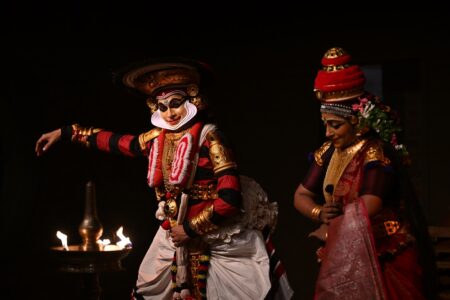Elevating it from the folk tradition, Natyashastra reformed Sanskrit Theatre. However, at present, Koodiyattam is the only surviving link to its past
Natyashastra symbolizes three streams of culture: the Vedic one represented by Indra, the Indus civilization represented by Siva and the folk tradition of Krishna. Natya has its starting point with the festival of Indra followed by the dance of Siva which made it more attractive. Music and dance were inherited from the Indus civilization. The folk tradition from Krishna was infused life into theatre. Undoubtedly, the fusion of these elements took a long time to evolve.
The Vedic connection of Natyashastra could be seen in the very first chapter that explains the genesis of Natya. Indra accompanied by gods requested Brahma to create a form of entertainment accessible to all classes of the society including the Sudras as they were prevented from listening to the Vedas. Brahma acceded to their request by taking text from Rig Veda, music from Sama Veda, abhinaya from Yajur Veda and the sentiments from Atharva Veda to create the fifth Veda, NS. He handed it over to Indra who pleaded inability of the devas to enact the play. Brahma then revealed the same to sage Bharatha who with his hundred sons brought it to the earth.
The refinement
Bharatha’s contribution could be summed up as follows: He refined the rudimentary theatre, like Panini who refined the corrupt language. He thus gave grammar to the theatre. The popular theatre forms staged in the nook and corner of the country were brought into an auditorium. Koothambalam attached to temples in Kerala is a glaring example. The folk and popular stories were replaced by heroic characters like kings and nobles. He prescribed two levels of acting namely, Lokadharmi and Natyadharmi of which the prominence was given to the latter. Of the four folds of abhinaya, Satwika was elevated to a higher plane, others being considered inferior to it.
We can see that Bharatha’s concern was mainly the Rupakas (forms of dramas). The question of Uparupakas was left to Kohala, Bharata’s disciple. The ten Rupakas are Nataka, Prakarana, Bhana, Vyayoga, Samavakara, Veethi, Ihamruga, Prahasana and Dima.
Despite all the refinements, Bharatha could not avoid the indigenous practices. Prakarana did not match the sublime level of the Nataka. Characters were of lower birth though with high quality. Prahasana and Veethi were at much lower levels. Samavakara and Ihamruga contain haughty scenes that frightened ordinary spectators. Bhana imitated the libertine.
Margi and deshi
The golden era of Sanskrit theatre was the first millennium from 500 BCE to 400 CE. Natyasastra, dramas of Bhasa, Kalidasa and others belonged to this period. The next 500 years up to 1000 CE was also notable as it witnessed compositions of Harsha, Bhavabhuti, Bhattanarayana and others. Commentaries on Natyasastra by Lollata, Sankuka and Abhinavagupta emerged. But the next millennium was a period of decline when regional languages attained prominence. There was no significant contribution to Sanskrit theatre during this period at the national level. Thus the two distinct classifications in the history of theatre are the national called Margi and the regional called Deshi.
Regrettably, the national pattern began to disappear and after a few centuries of the second millennium, it was completely lost. At present, the only surviving link to the past of Sanskrit theatre is Koodiyattam, the form of Sanskrit theatre that Kerala has preserved. It remains as the only live source from which posterity can reconstruct the ancient mode of performance in Sanskrit Theatre.
Read Part I here




